Talent Management Report: Steel Co. Performance, Rewards, and HR
VerifiedAdded on 2020/06/05
|10
|2657
|324
Report
AI Summary
This report examines talent management practices at Steel Co., a small manufacturing organization. It analyzes the contributions of individual and team performance to organizational value, highlighting the importance of training, communication, and leadership styles. The report explores the role of performance management systems in employee development, communication, and integration with HR processes, emphasizing the benefits of training, coaching, and effective communication channels. Furthermore, it investigates the effectiveness of linking performance to financial rewards, discussing its impact on employee motivation, self-esteem, and career development. The report concludes by summarizing the key findings and implications for Steel Co., emphasizing the importance of a holistic approach to talent management for improved performance and employee engagement.
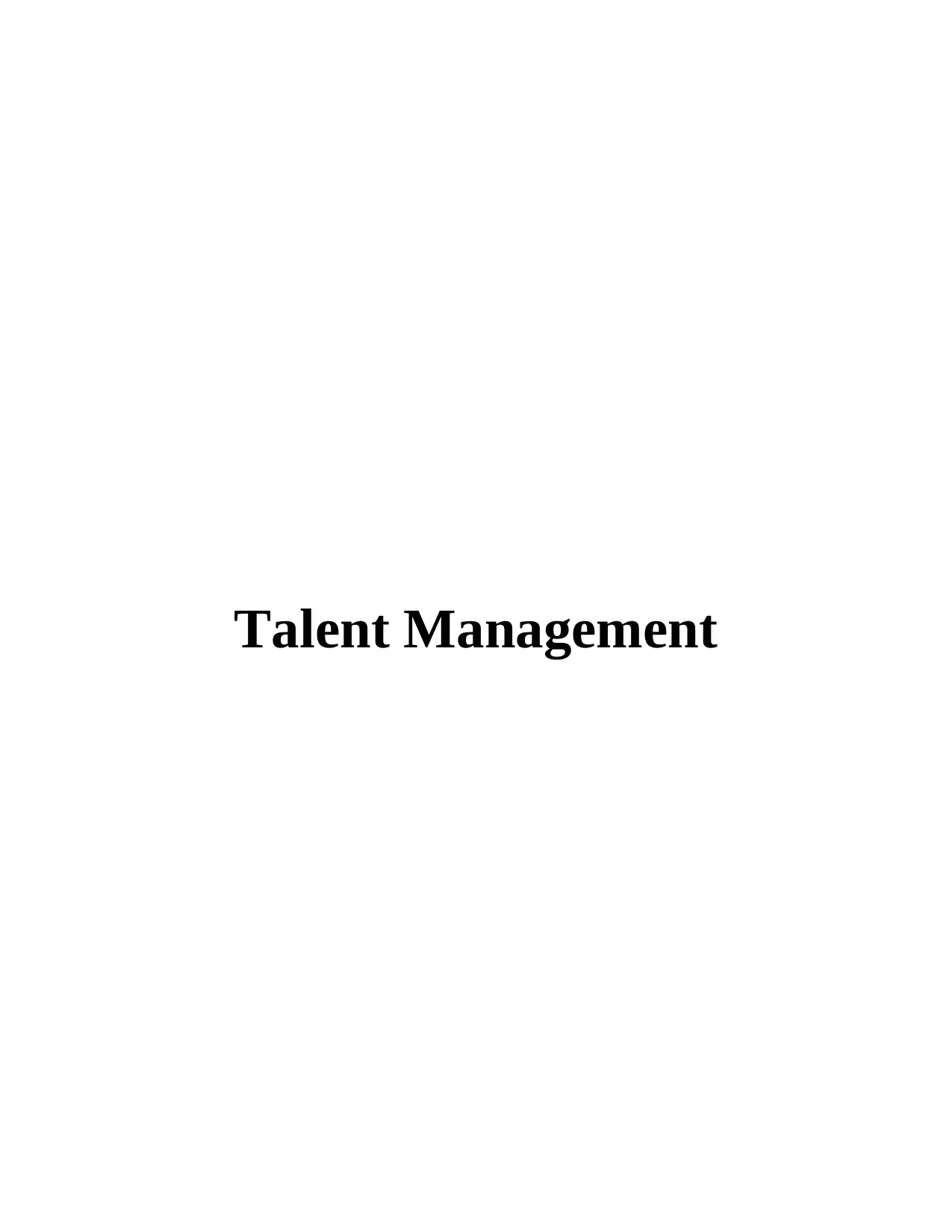
Talent Management
Paraphrase This Document
Need a fresh take? Get an instant paraphrase of this document with our AI Paraphraser
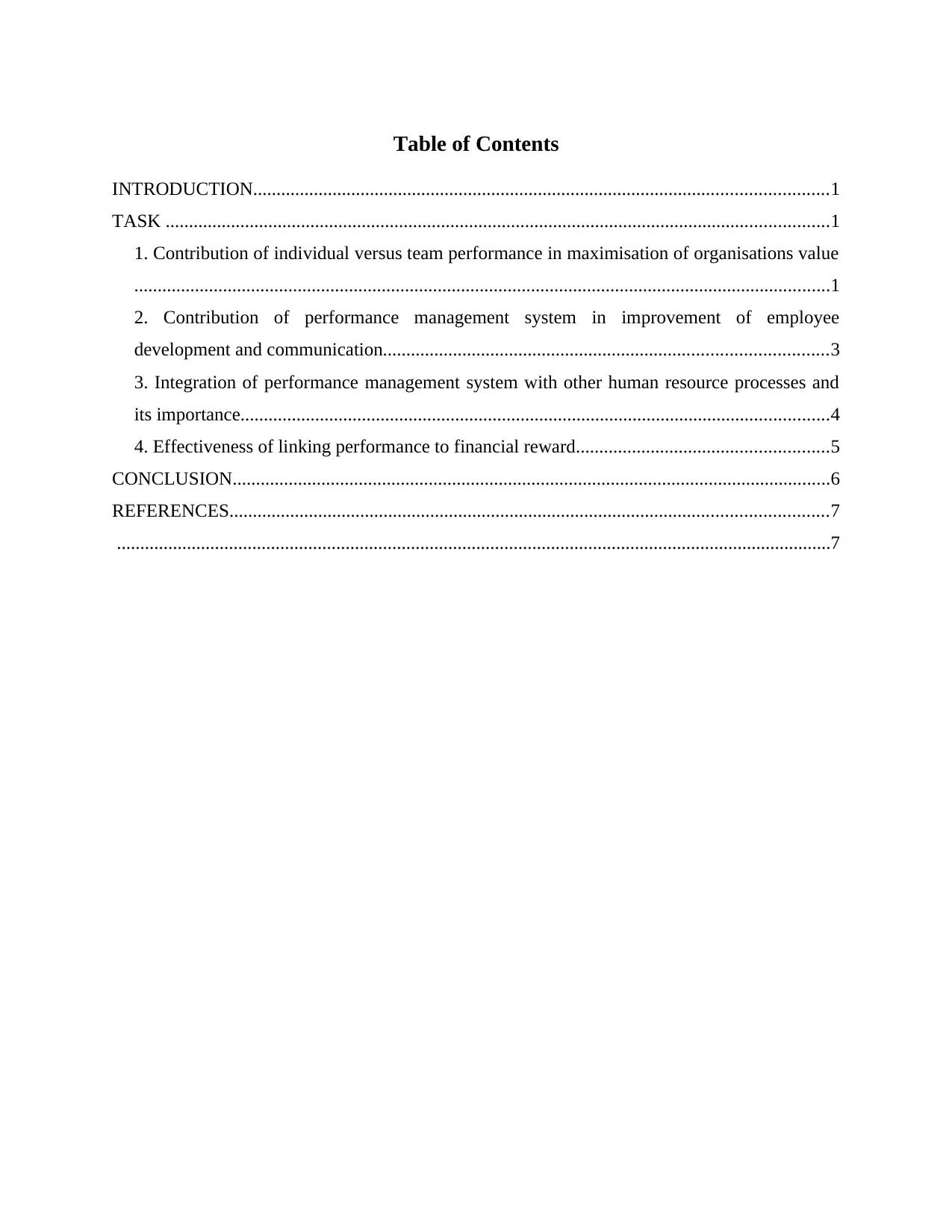
Table of Contents
INTRODUCTION...........................................................................................................................1
TASK ..............................................................................................................................................1
1. Contribution of individual versus team performance in maximisation of organisations value
.....................................................................................................................................................1
2. Contribution of performance management system in improvement of employee
development and communication...............................................................................................3
3. Integration of performance management system with other human resource processes and
its importance..............................................................................................................................4
4. Effectiveness of linking performance to financial reward......................................................5
CONCLUSION................................................................................................................................6
REFERENCES................................................................................................................................7
.........................................................................................................................................................7
INTRODUCTION...........................................................................................................................1
TASK ..............................................................................................................................................1
1. Contribution of individual versus team performance in maximisation of organisations value
.....................................................................................................................................................1
2. Contribution of performance management system in improvement of employee
development and communication...............................................................................................3
3. Integration of performance management system with other human resource processes and
its importance..............................................................................................................................4
4. Effectiveness of linking performance to financial reward......................................................5
CONCLUSION................................................................................................................................6
REFERENCES................................................................................................................................7
.........................................................................................................................................................7

⊘ This is a preview!⊘
Do you want full access?
Subscribe today to unlock all pages.

Trusted by 1+ million students worldwide
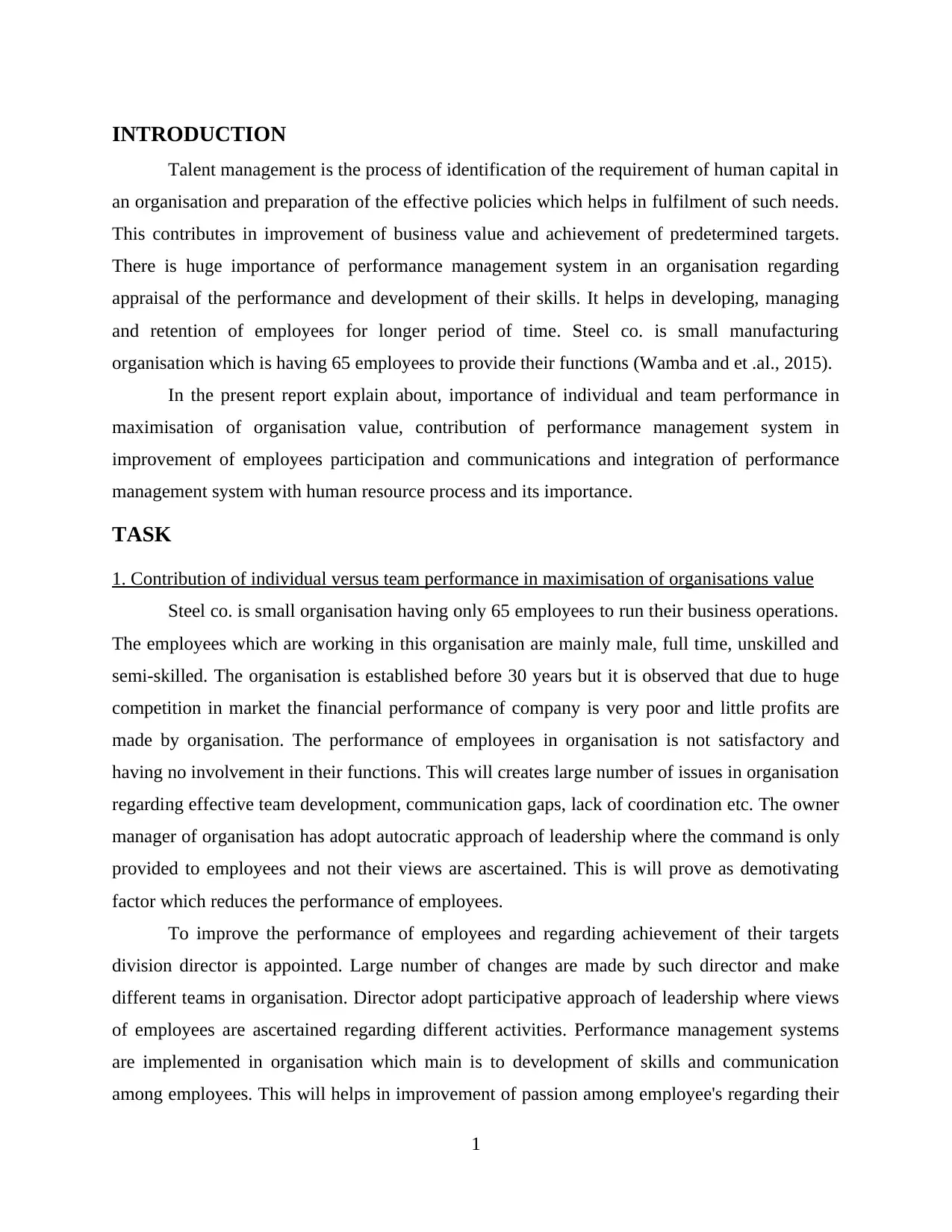
INTRODUCTION
Talent management is the process of identification of the requirement of human capital in
an organisation and preparation of the effective policies which helps in fulfilment of such needs.
This contributes in improvement of business value and achievement of predetermined targets.
There is huge importance of performance management system in an organisation regarding
appraisal of the performance and development of their skills. It helps in developing, managing
and retention of employees for longer period of time. Steel co. is small manufacturing
organisation which is having 65 employees to provide their functions (Wamba and et .al., 2015).
In the present report explain about, importance of individual and team performance in
maximisation of organisation value, contribution of performance management system in
improvement of employees participation and communications and integration of performance
management system with human resource process and its importance.
TASK
1. Contribution of individual versus team performance in maximisation of organisations value
Steel co. is small organisation having only 65 employees to run their business operations.
The employees which are working in this organisation are mainly male, full time, unskilled and
semi-skilled. The organisation is established before 30 years but it is observed that due to huge
competition in market the financial performance of company is very poor and little profits are
made by organisation. The performance of employees in organisation is not satisfactory and
having no involvement in their functions. This will creates large number of issues in organisation
regarding effective team development, communication gaps, lack of coordination etc. The owner
manager of organisation has adopt autocratic approach of leadership where the command is only
provided to employees and not their views are ascertained. This is will prove as demotivating
factor which reduces the performance of employees.
To improve the performance of employees and regarding achievement of their targets
division director is appointed. Large number of changes are made by such director and make
different teams in organisation. Director adopt participative approach of leadership where views
of employees are ascertained regarding different activities. Performance management systems
are implemented in organisation which main is to development of skills and communication
among employees. This will helps in improvement of passion among employee's regarding their
1
Talent management is the process of identification of the requirement of human capital in
an organisation and preparation of the effective policies which helps in fulfilment of such needs.
This contributes in improvement of business value and achievement of predetermined targets.
There is huge importance of performance management system in an organisation regarding
appraisal of the performance and development of their skills. It helps in developing, managing
and retention of employees for longer period of time. Steel co. is small manufacturing
organisation which is having 65 employees to provide their functions (Wamba and et .al., 2015).
In the present report explain about, importance of individual and team performance in
maximisation of organisation value, contribution of performance management system in
improvement of employees participation and communications and integration of performance
management system with human resource process and its importance.
TASK
1. Contribution of individual versus team performance in maximisation of organisations value
Steel co. is small organisation having only 65 employees to run their business operations.
The employees which are working in this organisation are mainly male, full time, unskilled and
semi-skilled. The organisation is established before 30 years but it is observed that due to huge
competition in market the financial performance of company is very poor and little profits are
made by organisation. The performance of employees in organisation is not satisfactory and
having no involvement in their functions. This will creates large number of issues in organisation
regarding effective team development, communication gaps, lack of coordination etc. The owner
manager of organisation has adopt autocratic approach of leadership where the command is only
provided to employees and not their views are ascertained. This is will prove as demotivating
factor which reduces the performance of employees.
To improve the performance of employees and regarding achievement of their targets
division director is appointed. Large number of changes are made by such director and make
different teams in organisation. Director adopt participative approach of leadership where views
of employees are ascertained regarding different activities. Performance management systems
are implemented in organisation which main is to development of skills and communication
among employees. This will helps in improvement of passion among employee's regarding their
1
Paraphrase This Document
Need a fresh take? Get an instant paraphrase of this document with our AI Paraphraser
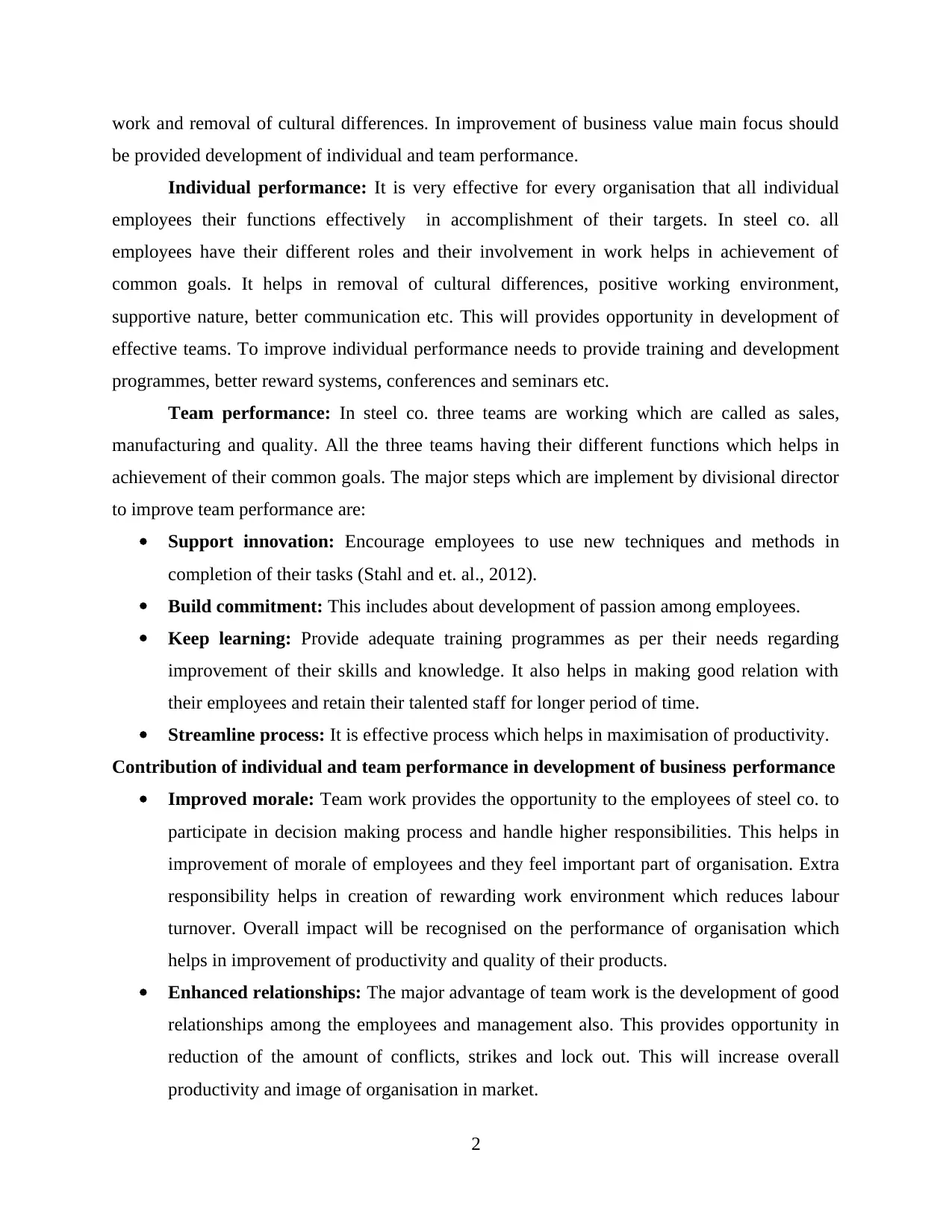
work and removal of cultural differences. In improvement of business value main focus should
be provided development of individual and team performance.
Individual performance: It is very effective for every organisation that all individual
employees their functions effectively in accomplishment of their targets. In steel co. all
employees have their different roles and their involvement in work helps in achievement of
common goals. It helps in removal of cultural differences, positive working environment,
supportive nature, better communication etc. This will provides opportunity in development of
effective teams. To improve individual performance needs to provide training and development
programmes, better reward systems, conferences and seminars etc.
Team performance: In steel co. three teams are working which are called as sales,
manufacturing and quality. All the three teams having their different functions which helps in
achievement of their common goals. The major steps which are implement by divisional director
to improve team performance are:
Support innovation: Encourage employees to use new techniques and methods in
completion of their tasks (Stahl and et. al., 2012).
Build commitment: This includes about development of passion among employees.
Keep learning: Provide adequate training programmes as per their needs regarding
improvement of their skills and knowledge. It also helps in making good relation with
their employees and retain their talented staff for longer period of time.
Streamline process: It is effective process which helps in maximisation of productivity.
Contribution of individual and team performance in development of business performance
Improved morale: Team work provides the opportunity to the employees of steel co. to
participate in decision making process and handle higher responsibilities. This helps in
improvement of morale of employees and they feel important part of organisation. Extra
responsibility helps in creation of rewarding work environment which reduces labour
turnover. Overall impact will be recognised on the performance of organisation which
helps in improvement of productivity and quality of their products.
Enhanced relationships: The major advantage of team work is the development of good
relationships among the employees and management also. This provides opportunity in
reduction of the amount of conflicts, strikes and lock out. This will increase overall
productivity and image of organisation in market.
2
be provided development of individual and team performance.
Individual performance: It is very effective for every organisation that all individual
employees their functions effectively in accomplishment of their targets. In steel co. all
employees have their different roles and their involvement in work helps in achievement of
common goals. It helps in removal of cultural differences, positive working environment,
supportive nature, better communication etc. This will provides opportunity in development of
effective teams. To improve individual performance needs to provide training and development
programmes, better reward systems, conferences and seminars etc.
Team performance: In steel co. three teams are working which are called as sales,
manufacturing and quality. All the three teams having their different functions which helps in
achievement of their common goals. The major steps which are implement by divisional director
to improve team performance are:
Support innovation: Encourage employees to use new techniques and methods in
completion of their tasks (Stahl and et. al., 2012).
Build commitment: This includes about development of passion among employees.
Keep learning: Provide adequate training programmes as per their needs regarding
improvement of their skills and knowledge. It also helps in making good relation with
their employees and retain their talented staff for longer period of time.
Streamline process: It is effective process which helps in maximisation of productivity.
Contribution of individual and team performance in development of business performance
Improved morale: Team work provides the opportunity to the employees of steel co. to
participate in decision making process and handle higher responsibilities. This helps in
improvement of morale of employees and they feel important part of organisation. Extra
responsibility helps in creation of rewarding work environment which reduces labour
turnover. Overall impact will be recognised on the performance of organisation which
helps in improvement of productivity and quality of their products.
Enhanced relationships: The major advantage of team work is the development of good
relationships among the employees and management also. This provides opportunity in
reduction of the amount of conflicts, strikes and lock out. This will increase overall
productivity and image of organisation in market.
2
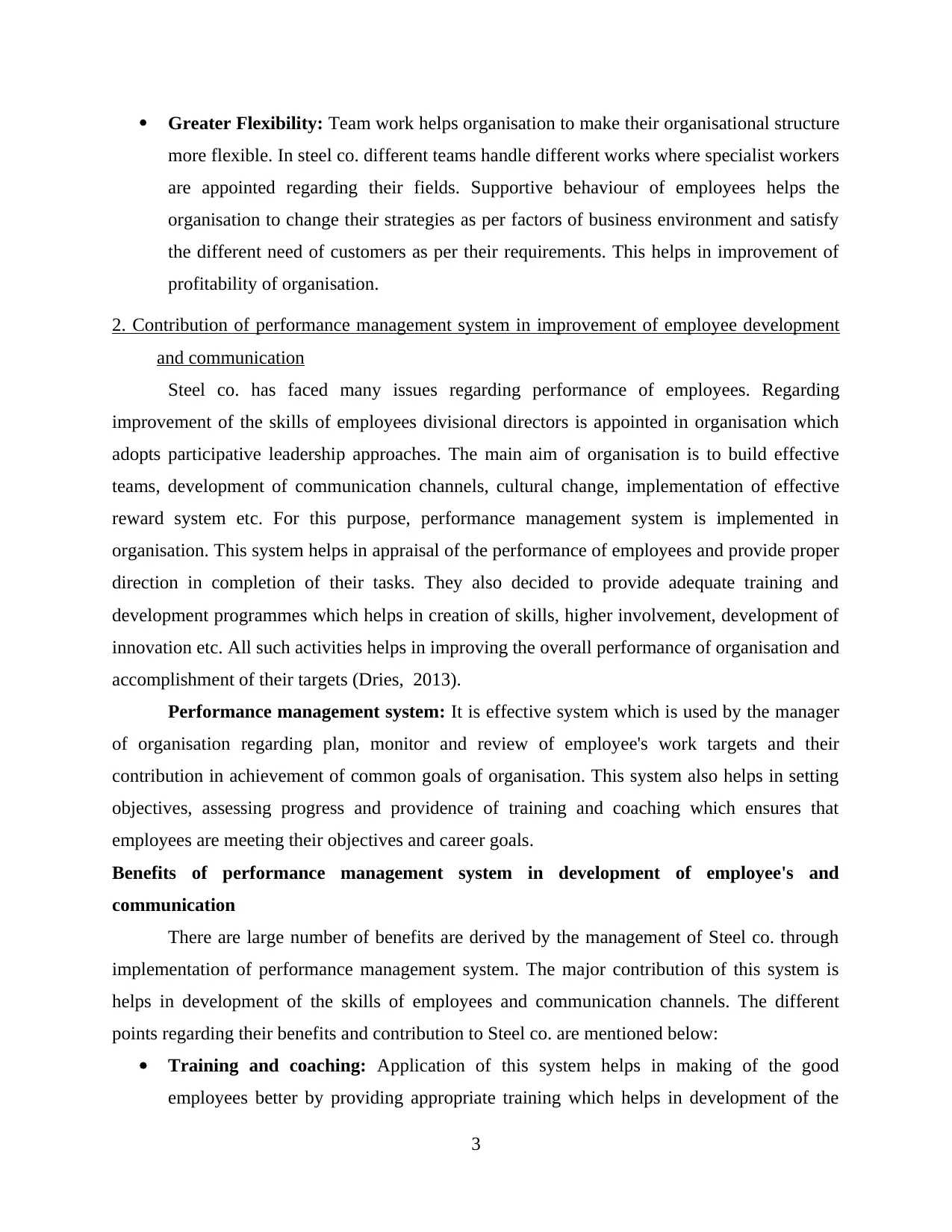
Greater Flexibility: Team work helps organisation to make their organisational structure
more flexible. In steel co. different teams handle different works where specialist workers
are appointed regarding their fields. Supportive behaviour of employees helps the
organisation to change their strategies as per factors of business environment and satisfy
the different need of customers as per their requirements. This helps in improvement of
profitability of organisation.
2. Contribution of performance management system in improvement of employee development
and communication
Steel co. has faced many issues regarding performance of employees. Regarding
improvement of the skills of employees divisional directors is appointed in organisation which
adopts participative leadership approaches. The main aim of organisation is to build effective
teams, development of communication channels, cultural change, implementation of effective
reward system etc. For this purpose, performance management system is implemented in
organisation. This system helps in appraisal of the performance of employees and provide proper
direction in completion of their tasks. They also decided to provide adequate training and
development programmes which helps in creation of skills, higher involvement, development of
innovation etc. All such activities helps in improving the overall performance of organisation and
accomplishment of their targets (Dries, 2013).
Performance management system: It is effective system which is used by the manager
of organisation regarding plan, monitor and review of employee's work targets and their
contribution in achievement of common goals of organisation. This system also helps in setting
objectives, assessing progress and providence of training and coaching which ensures that
employees are meeting their objectives and career goals.
Benefits of performance management system in development of employee's and
communication
There are large number of benefits are derived by the management of Steel co. through
implementation of performance management system. The major contribution of this system is
helps in development of the skills of employees and communication channels. The different
points regarding their benefits and contribution to Steel co. are mentioned below:
Training and coaching: Application of this system helps in making of the good
employees better by providing appropriate training which helps in development of the
3
more flexible. In steel co. different teams handle different works where specialist workers
are appointed regarding their fields. Supportive behaviour of employees helps the
organisation to change their strategies as per factors of business environment and satisfy
the different need of customers as per their requirements. This helps in improvement of
profitability of organisation.
2. Contribution of performance management system in improvement of employee development
and communication
Steel co. has faced many issues regarding performance of employees. Regarding
improvement of the skills of employees divisional directors is appointed in organisation which
adopts participative leadership approaches. The main aim of organisation is to build effective
teams, development of communication channels, cultural change, implementation of effective
reward system etc. For this purpose, performance management system is implemented in
organisation. This system helps in appraisal of the performance of employees and provide proper
direction in completion of their tasks. They also decided to provide adequate training and
development programmes which helps in creation of skills, higher involvement, development of
innovation etc. All such activities helps in improving the overall performance of organisation and
accomplishment of their targets (Dries, 2013).
Performance management system: It is effective system which is used by the manager
of organisation regarding plan, monitor and review of employee's work targets and their
contribution in achievement of common goals of organisation. This system also helps in setting
objectives, assessing progress and providence of training and coaching which ensures that
employees are meeting their objectives and career goals.
Benefits of performance management system in development of employee's and
communication
There are large number of benefits are derived by the management of Steel co. through
implementation of performance management system. The major contribution of this system is
helps in development of the skills of employees and communication channels. The different
points regarding their benefits and contribution to Steel co. are mentioned below:
Training and coaching: Application of this system helps in making of the good
employees better by providing appropriate training which helps in development of the
3
⊘ This is a preview!⊘
Do you want full access?
Subscribe today to unlock all pages.

Trusted by 1+ million students worldwide
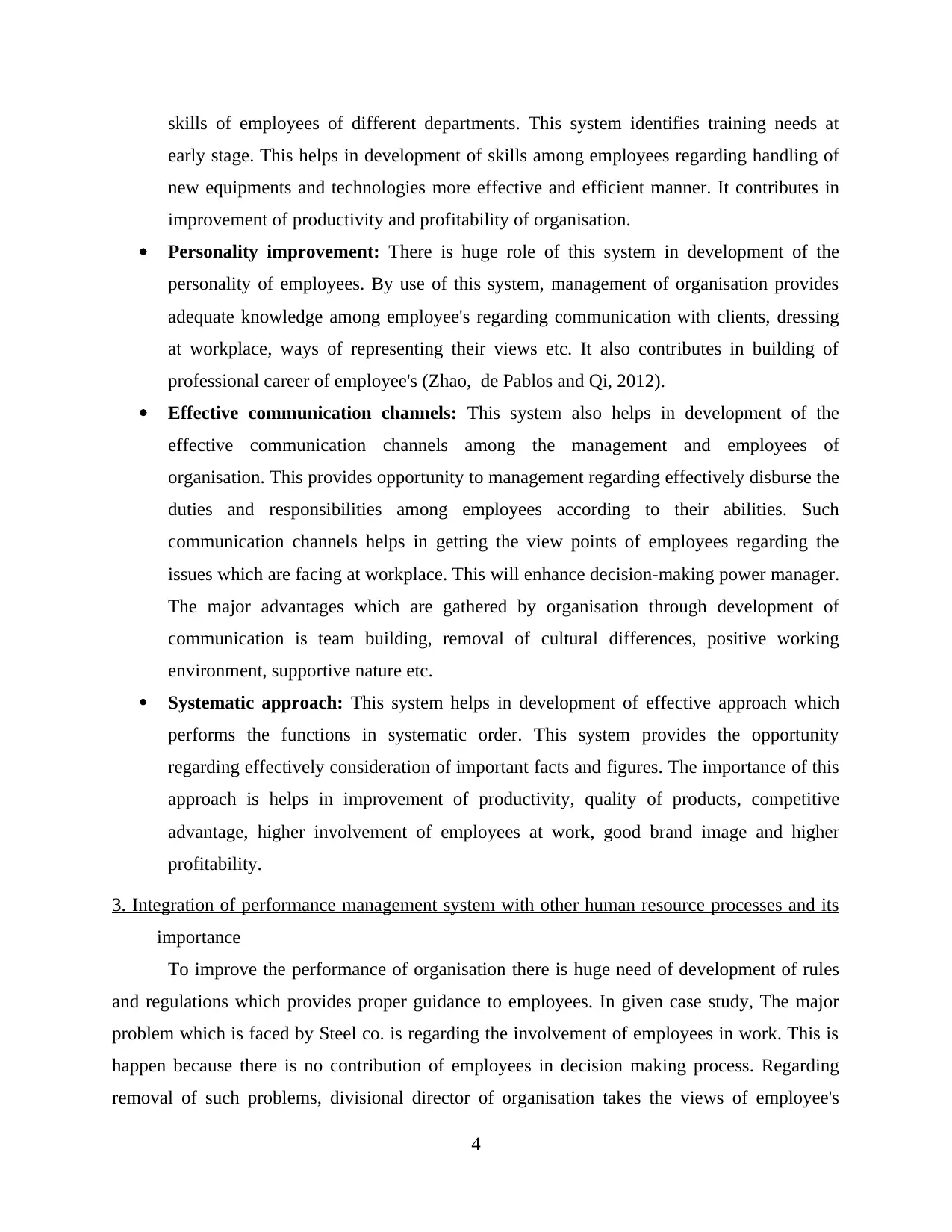
skills of employees of different departments. This system identifies training needs at
early stage. This helps in development of skills among employees regarding handling of
new equipments and technologies more effective and efficient manner. It contributes in
improvement of productivity and profitability of organisation.
Personality improvement: There is huge role of this system in development of the
personality of employees. By use of this system, management of organisation provides
adequate knowledge among employee's regarding communication with clients, dressing
at workplace, ways of representing their views etc. It also contributes in building of
professional career of employee's (Zhao, de Pablos and Qi, 2012).
Effective communication channels: This system also helps in development of the
effective communication channels among the management and employees of
organisation. This provides opportunity to management regarding effectively disburse the
duties and responsibilities among employees according to their abilities. Such
communication channels helps in getting the view points of employees regarding the
issues which are facing at workplace. This will enhance decision-making power manager.
The major advantages which are gathered by organisation through development of
communication is team building, removal of cultural differences, positive working
environment, supportive nature etc.
Systematic approach: This system helps in development of effective approach which
performs the functions in systematic order. This system provides the opportunity
regarding effectively consideration of important facts and figures. The importance of this
approach is helps in improvement of productivity, quality of products, competitive
advantage, higher involvement of employees at work, good brand image and higher
profitability.
3. Integration of performance management system with other human resource processes and its
importance
To improve the performance of organisation there is huge need of development of rules
and regulations which provides proper guidance to employees. In given case study, The major
problem which is faced by Steel co. is regarding the involvement of employees in work. This is
happen because there is no contribution of employees in decision making process. Regarding
removal of such problems, divisional director of organisation takes the views of employee's
4
early stage. This helps in development of skills among employees regarding handling of
new equipments and technologies more effective and efficient manner. It contributes in
improvement of productivity and profitability of organisation.
Personality improvement: There is huge role of this system in development of the
personality of employees. By use of this system, management of organisation provides
adequate knowledge among employee's regarding communication with clients, dressing
at workplace, ways of representing their views etc. It also contributes in building of
professional career of employee's (Zhao, de Pablos and Qi, 2012).
Effective communication channels: This system also helps in development of the
effective communication channels among the management and employees of
organisation. This provides opportunity to management regarding effectively disburse the
duties and responsibilities among employees according to their abilities. Such
communication channels helps in getting the view points of employees regarding the
issues which are facing at workplace. This will enhance decision-making power manager.
The major advantages which are gathered by organisation through development of
communication is team building, removal of cultural differences, positive working
environment, supportive nature etc.
Systematic approach: This system helps in development of effective approach which
performs the functions in systematic order. This system provides the opportunity
regarding effectively consideration of important facts and figures. The importance of this
approach is helps in improvement of productivity, quality of products, competitive
advantage, higher involvement of employees at work, good brand image and higher
profitability.
3. Integration of performance management system with other human resource processes and its
importance
To improve the performance of organisation there is huge need of development of rules
and regulations which provides proper guidance to employees. In given case study, The major
problem which is faced by Steel co. is regarding the involvement of employees in work. This is
happen because there is no contribution of employees in decision making process. Regarding
removal of such problems, divisional director of organisation takes the views of employee's
4
Paraphrase This Document
Need a fresh take? Get an instant paraphrase of this document with our AI Paraphraser
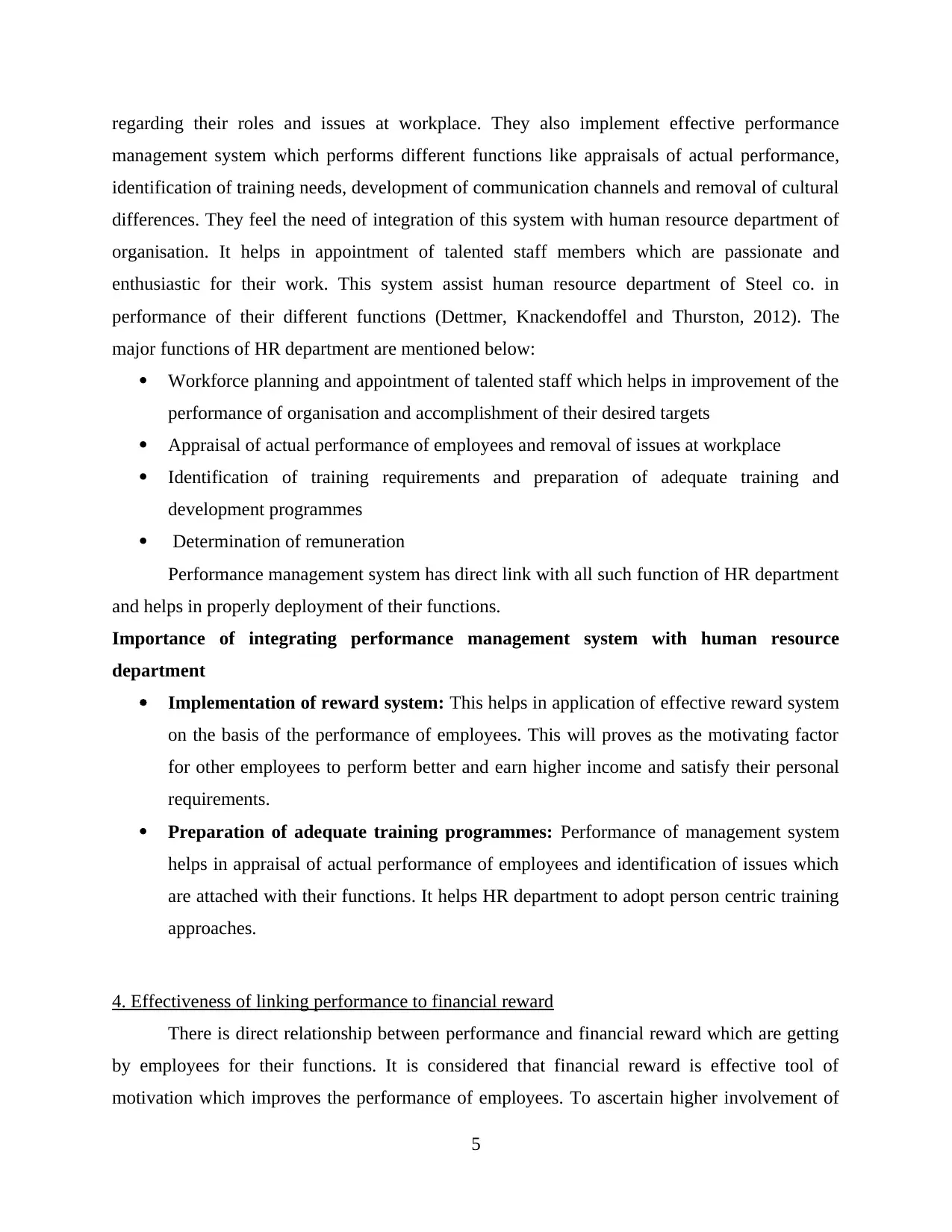
regarding their roles and issues at workplace. They also implement effective performance
management system which performs different functions like appraisals of actual performance,
identification of training needs, development of communication channels and removal of cultural
differences. They feel the need of integration of this system with human resource department of
organisation. It helps in appointment of talented staff members which are passionate and
enthusiastic for their work. This system assist human resource department of Steel co. in
performance of their different functions (Dettmer, Knackendoffel and Thurston, 2012). The
major functions of HR department are mentioned below:
Workforce planning and appointment of talented staff which helps in improvement of the
performance of organisation and accomplishment of their desired targets
Appraisal of actual performance of employees and removal of issues at workplace
Identification of training requirements and preparation of adequate training and
development programmes
Determination of remuneration
Performance management system has direct link with all such function of HR department
and helps in properly deployment of their functions.
Importance of integrating performance management system with human resource
department
Implementation of reward system: This helps in application of effective reward system
on the basis of the performance of employees. This will proves as the motivating factor
for other employees to perform better and earn higher income and satisfy their personal
requirements.
Preparation of adequate training programmes: Performance of management system
helps in appraisal of actual performance of employees and identification of issues which
are attached with their functions. It helps HR department to adopt person centric training
approaches.
4. Effectiveness of linking performance to financial reward
There is direct relationship between performance and financial reward which are getting
by employees for their functions. It is considered that financial reward is effective tool of
motivation which improves the performance of employees. To ascertain higher involvement of
5
management system which performs different functions like appraisals of actual performance,
identification of training needs, development of communication channels and removal of cultural
differences. They feel the need of integration of this system with human resource department of
organisation. It helps in appointment of talented staff members which are passionate and
enthusiastic for their work. This system assist human resource department of Steel co. in
performance of their different functions (Dettmer, Knackendoffel and Thurston, 2012). The
major functions of HR department are mentioned below:
Workforce planning and appointment of talented staff which helps in improvement of the
performance of organisation and accomplishment of their desired targets
Appraisal of actual performance of employees and removal of issues at workplace
Identification of training requirements and preparation of adequate training and
development programmes
Determination of remuneration
Performance management system has direct link with all such function of HR department
and helps in properly deployment of their functions.
Importance of integrating performance management system with human resource
department
Implementation of reward system: This helps in application of effective reward system
on the basis of the performance of employees. This will proves as the motivating factor
for other employees to perform better and earn higher income and satisfy their personal
requirements.
Preparation of adequate training programmes: Performance of management system
helps in appraisal of actual performance of employees and identification of issues which
are attached with their functions. It helps HR department to adopt person centric training
approaches.
4. Effectiveness of linking performance to financial reward
There is direct relationship between performance and financial reward which are getting
by employees for their functions. It is considered that financial reward is effective tool of
motivation which improves the performance of employees. To ascertain higher involvement of
5
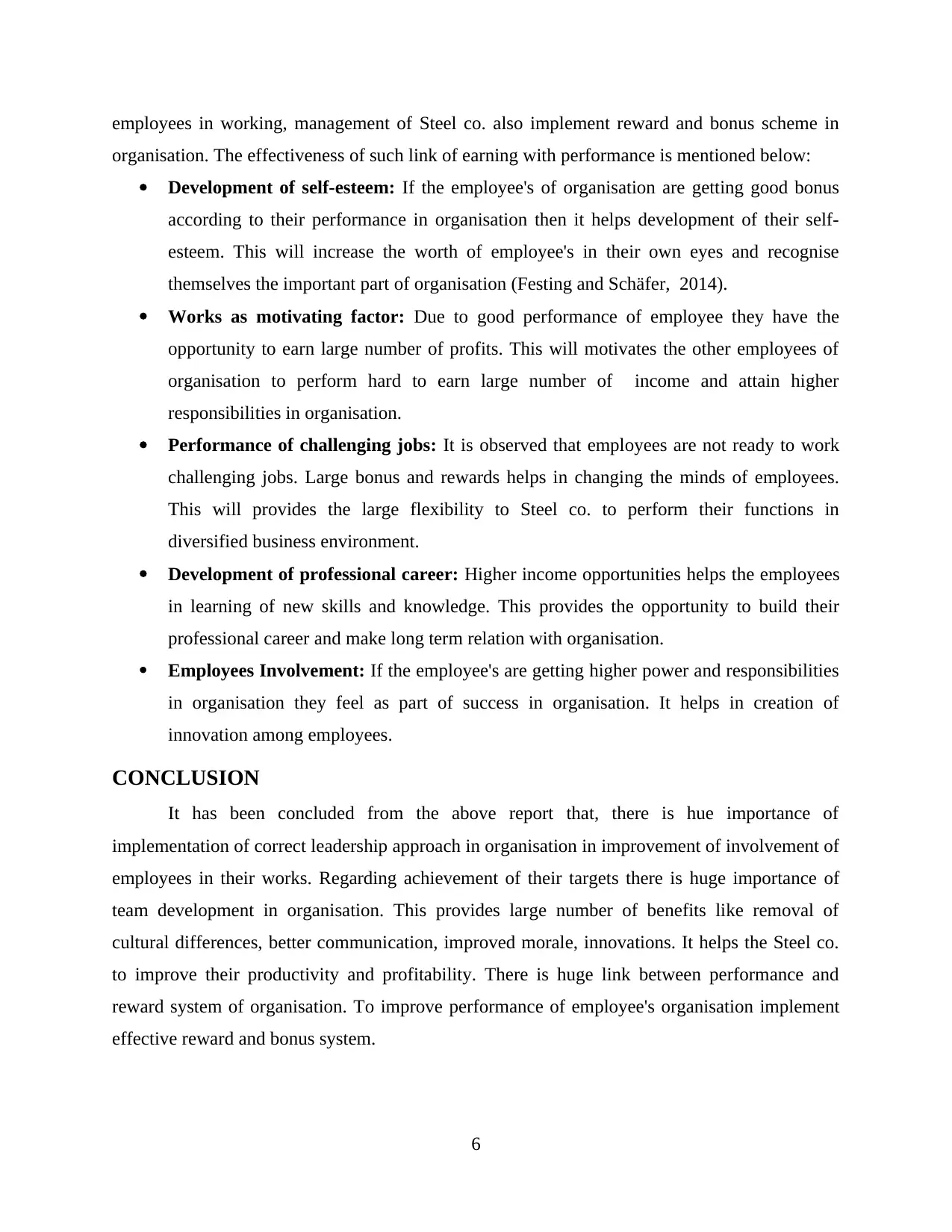
employees in working, management of Steel co. also implement reward and bonus scheme in
organisation. The effectiveness of such link of earning with performance is mentioned below:
Development of self-esteem: If the employee's of organisation are getting good bonus
according to their performance in organisation then it helps development of their self-
esteem. This will increase the worth of employee's in their own eyes and recognise
themselves the important part of organisation (Festing and Schäfer, 2014).
Works as motivating factor: Due to good performance of employee they have the
opportunity to earn large number of profits. This will motivates the other employees of
organisation to perform hard to earn large number of income and attain higher
responsibilities in organisation.
Performance of challenging jobs: It is observed that employees are not ready to work
challenging jobs. Large bonus and rewards helps in changing the minds of employees.
This will provides the large flexibility to Steel co. to perform their functions in
diversified business environment.
Development of professional career: Higher income opportunities helps the employees
in learning of new skills and knowledge. This provides the opportunity to build their
professional career and make long term relation with organisation.
Employees Involvement: If the employee's are getting higher power and responsibilities
in organisation they feel as part of success in organisation. It helps in creation of
innovation among employees.
CONCLUSION
It has been concluded from the above report that, there is hue importance of
implementation of correct leadership approach in organisation in improvement of involvement of
employees in their works. Regarding achievement of their targets there is huge importance of
team development in organisation. This provides large number of benefits like removal of
cultural differences, better communication, improved morale, innovations. It helps the Steel co.
to improve their productivity and profitability. There is huge link between performance and
reward system of organisation. To improve performance of employee's organisation implement
effective reward and bonus system.
6
organisation. The effectiveness of such link of earning with performance is mentioned below:
Development of self-esteem: If the employee's of organisation are getting good bonus
according to their performance in organisation then it helps development of their self-
esteem. This will increase the worth of employee's in their own eyes and recognise
themselves the important part of organisation (Festing and Schäfer, 2014).
Works as motivating factor: Due to good performance of employee they have the
opportunity to earn large number of profits. This will motivates the other employees of
organisation to perform hard to earn large number of income and attain higher
responsibilities in organisation.
Performance of challenging jobs: It is observed that employees are not ready to work
challenging jobs. Large bonus and rewards helps in changing the minds of employees.
This will provides the large flexibility to Steel co. to perform their functions in
diversified business environment.
Development of professional career: Higher income opportunities helps the employees
in learning of new skills and knowledge. This provides the opportunity to build their
professional career and make long term relation with organisation.
Employees Involvement: If the employee's are getting higher power and responsibilities
in organisation they feel as part of success in organisation. It helps in creation of
innovation among employees.
CONCLUSION
It has been concluded from the above report that, there is hue importance of
implementation of correct leadership approach in organisation in improvement of involvement of
employees in their works. Regarding achievement of their targets there is huge importance of
team development in organisation. This provides large number of benefits like removal of
cultural differences, better communication, improved morale, innovations. It helps the Steel co.
to improve their productivity and profitability. There is huge link between performance and
reward system of organisation. To improve performance of employee's organisation implement
effective reward and bonus system.
6
⊘ This is a preview!⊘
Do you want full access?
Subscribe today to unlock all pages.

Trusted by 1+ million students worldwide
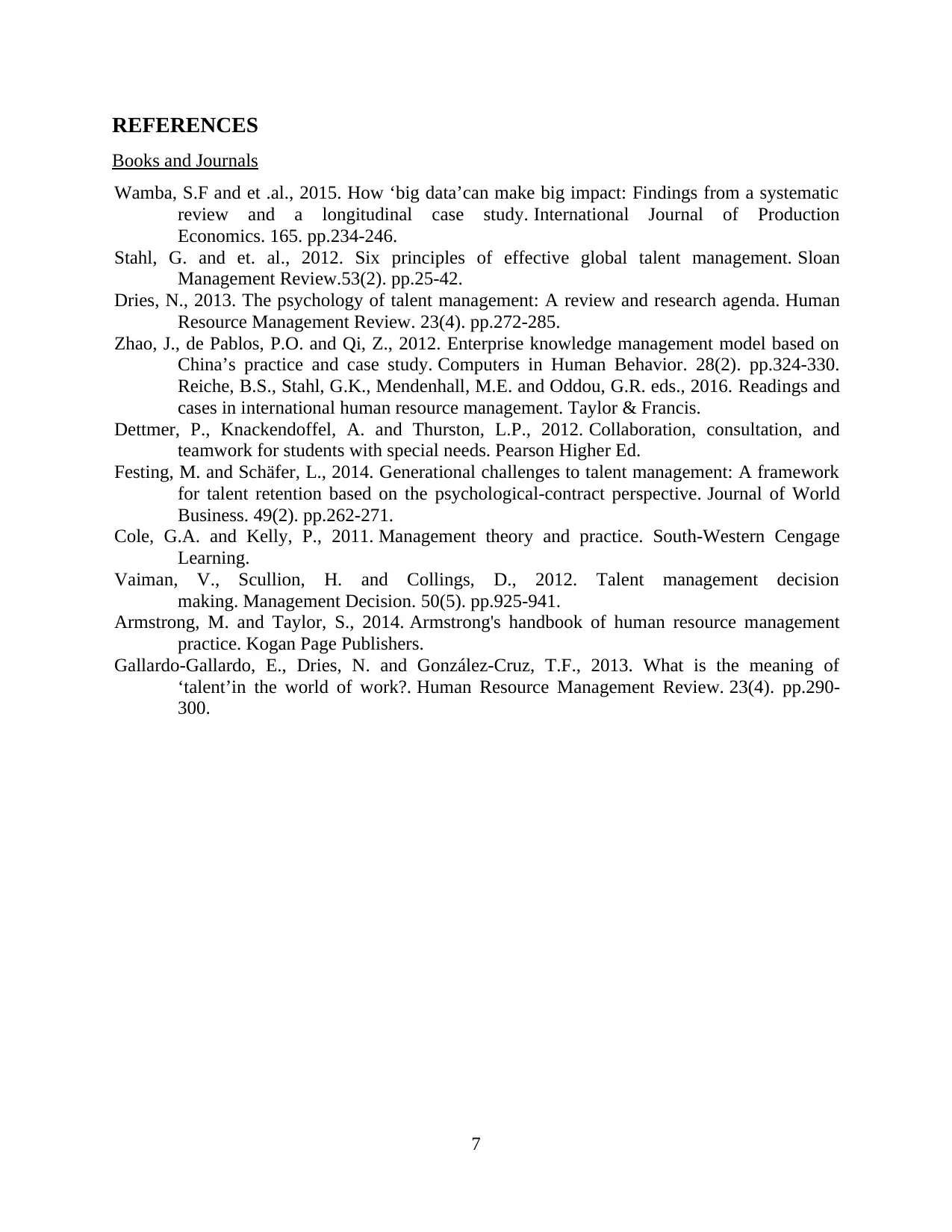
REFERENCES
Books and Journals
Wamba, S.F and et .al., 2015. How ‘big data’can make big impact: Findings from a systematic
review and a longitudinal case study. International Journal of Production
Economics. 165. pp.234-246.
Stahl, G. and et. al., 2012. Six principles of effective global talent management. Sloan
Management Review.53(2). pp.25-42.
Dries, N., 2013. The psychology of talent management: A review and research agenda. Human
Resource Management Review. 23(4). pp.272-285.
Zhao, J., de Pablos, P.O. and Qi, Z., 2012. Enterprise knowledge management model based on
China’s practice and case study. Computers in Human Behavior. 28(2). pp.324-330.
Reiche, B.S., Stahl, G.K., Mendenhall, M.E. and Oddou, G.R. eds., 2016. Readings and
cases in international human resource management. Taylor & Francis.
Dettmer, P., Knackendoffel, A. and Thurston, L.P., 2012. Collaboration, consultation, and
teamwork for students with special needs. Pearson Higher Ed.
Festing, M. and Schäfer, L., 2014. Generational challenges to talent management: A framework
for talent retention based on the psychological-contract perspective. Journal of World
Business. 49(2). pp.262-271.
Cole, G.A. and Kelly, P., 2011. Management theory and practice. South-Western Cengage
Learning.
Vaiman, V., Scullion, H. and Collings, D., 2012. Talent management decision
making. Management Decision. 50(5). pp.925-941.
Armstrong, M. and Taylor, S., 2014. Armstrong's handbook of human resource management
practice. Kogan Page Publishers.
Gallardo-Gallardo, E., Dries, N. and González-Cruz, T.F., 2013. What is the meaning of
‘talent’in the world of work?. Human Resource Management Review. 23(4). pp.290-
300.
7
Books and Journals
Wamba, S.F and et .al., 2015. How ‘big data’can make big impact: Findings from a systematic
review and a longitudinal case study. International Journal of Production
Economics. 165. pp.234-246.
Stahl, G. and et. al., 2012. Six principles of effective global talent management. Sloan
Management Review.53(2). pp.25-42.
Dries, N., 2013. The psychology of talent management: A review and research agenda. Human
Resource Management Review. 23(4). pp.272-285.
Zhao, J., de Pablos, P.O. and Qi, Z., 2012. Enterprise knowledge management model based on
China’s practice and case study. Computers in Human Behavior. 28(2). pp.324-330.
Reiche, B.S., Stahl, G.K., Mendenhall, M.E. and Oddou, G.R. eds., 2016. Readings and
cases in international human resource management. Taylor & Francis.
Dettmer, P., Knackendoffel, A. and Thurston, L.P., 2012. Collaboration, consultation, and
teamwork for students with special needs. Pearson Higher Ed.
Festing, M. and Schäfer, L., 2014. Generational challenges to talent management: A framework
for talent retention based on the psychological-contract perspective. Journal of World
Business. 49(2). pp.262-271.
Cole, G.A. and Kelly, P., 2011. Management theory and practice. South-Western Cengage
Learning.
Vaiman, V., Scullion, H. and Collings, D., 2012. Talent management decision
making. Management Decision. 50(5). pp.925-941.
Armstrong, M. and Taylor, S., 2014. Armstrong's handbook of human resource management
practice. Kogan Page Publishers.
Gallardo-Gallardo, E., Dries, N. and González-Cruz, T.F., 2013. What is the meaning of
‘talent’in the world of work?. Human Resource Management Review. 23(4). pp.290-
300.
7
1 out of 10
Related Documents
Your All-in-One AI-Powered Toolkit for Academic Success.
+13062052269
info@desklib.com
Available 24*7 on WhatsApp / Email
![[object Object]](/_next/static/media/star-bottom.7253800d.svg)
Unlock your academic potential
Copyright © 2020–2025 A2Z Services. All Rights Reserved. Developed and managed by ZUCOL.





